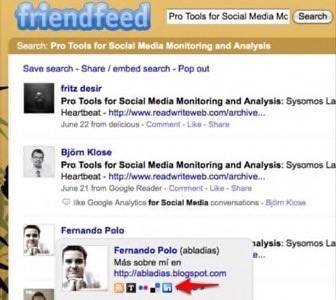FriendFeed, the multi-network activity aggregator co-founded by Gmail creator Paul Buchheit, announced today that it has entered the crowded field of real time search. FriendFeed was already the best way to learn what early adopter social media users were saying about any topic across blogs, Twitter, delicious and other diverse social media sites. If FriendFeed wants to step it up to the next level and challenge business-class conversation trackers, we believe there are four steps the company needs to take.

We think that would make a whole lot of sense. In fact we think that if real time search were turned into a business tool it could challenge social media monitoring services like Radian6, Scout Labs and Sysomos. Here’s what we think needs to happen in order for that to become a possibility.
We already use FriendFeed to keep track of who quietly touches our blog posts out around the web. For example, our recent post Google Updates Blog Search – Where’s The Innovation hasn’t gotten any comments yet – but FriendFeed shows us that leading marketing blogger Andy Beal shared it with his network on Google Reader. That’s good to know.
We think FriendFeed could offer some of the most sophisticated social media conversation tracking on the web, if it just took a few steps in particular.

Broaden the Index Beyond Opt-In
Right now FriendFeed tracks what users say and do across more than 40 different social media sites and any RSS feeds (like blog feeds) that users input as part of their profiles. It’s a great way to track people and topics on networks you yourself don’t participate in.
Because FriendFeed is such a high-profile startup, many people have set up accounts just to try it and have their activities pulled into the site automatically even though they no longer use FriendFeed itself. That adds to the richness of the site’s search function.
If FriendFeed wants to offer full-service conversation tracking, though, it is going to need to go beyond the early-adopter crowd that has opted in to having their activities imported into the site. FriendFeed is going to need to proactively discover and import feeds from users of Twitter, Delicious, SlideShare, BrightKite, etc., and bloggers who have not set up FriendFeed accounts. This will increase the usefulness of the site’s search function by an order of magnitude.
That’s no small task! Many startups have tried to do social-media-wide search in the past but few can achieve the scale and speed needed to pull it off well. Two things make us think FriendFeed can do it. First, who better than the creator of Gmail to achieve new heights in rapid, scalable information delivery? Buchheit isn’t the only former Googler on the team, either. Second, FriendFeed has been engineered from the start to import massive amounts of data. A number of the streams FriendFeed pulls in aren’t even from RSS feeds as you’d expect; the company’s co-founders told ReadWriteWeb in an early interview that they import from a wide variety of Application Programming Interfaces (APIs) beyond RSS.
Spam Control
Right now there’s a fair amount of spam on FriendFeed and we imagine it’s only going to get worse. There’s also a lot of people who use the service as their RSS reader – so blog posts and search results show up in your search results even though no one has touched them.
This wouldn’t be a difficult problem to solve. FriendFeed is just a few steps away already from allowing searchers to query all sources other than manually imported RSS feeds except when a feed item has one or more comments or “likes” added by a user.
Apply Business Savvy
There are all kinds of ways that FriendFeed could become more business savvy. One way we would suggest is through making more use of LinkedIn.
FriendFeed users have been able to associate their LinkedIn profiles with their FriendFeed accounts since the start of the service, and job changes used to be displayed right along with Tweets and other online activity. It was great. Unfortunately, LinkedIn knows what a pot of gold it sits on and took the noxious step of cutting off these kinds of importing functions by obscuring the HTML on its profile pages. FriendFeed was scraping those pages for changes and it was a great service for everyone. It was pure folly by LinkedIn; it wasn’t specifically targeting FriendFeed, but as a result FriendFeed users no longer see when their friends change jobs and so no longer click through to LinkedIn to learn more.
Fortunately FriendFeed hasn’t removed LinkedIn as a field that can be viewed by users; it just doesn’t update anymore. When you see that someone has said something in your search stream, you can often click through to their LinkedIn profile to see what they do for a living and what their job title is. FriendFeed could display job titles by default on a business version of FriendFeed if LinkedIn was more agreeable, or FriendFeed could look to the much friendlier and social media-savvy Google Profiles instead.
Knowing the job titles of people who have bookmarked your web page in Delicious or shared it in Google Reader would be really valuable.
Some other business-oriented rules, like alerts when certain discussion thresholds have been reached, would go a long way too.
Bring Back Aggregate Analysis
When FriendFeed launched, it offered some great data visualization, showing you the users whose content you “liked” the most and who “liked” your content the most. It showed in a pie chart which services most of your content came in through.
Unfortunately, in a recent redesign aimed to make the service more mainstream-user friendly, those visualizations were eliminated.
Bring that and more back and you’ve got a viable competitor for services that businesses pay hundreds or thousands of dollars a year for. Add some sentiment analysis, made easier by FriendFeed’s “like” feedback function, and you’ve got a really desirable product.
Will FriendFeed take these steps though? That depends on whether it continues its Quixotic quest to capture more everyday consumer users for a cross-network, real-time conversation aggregator (!) or finds audiences that appreciate its value and starts building out features that they will pay for.





















